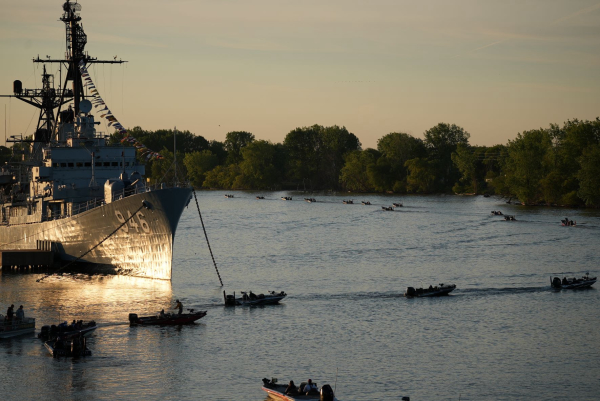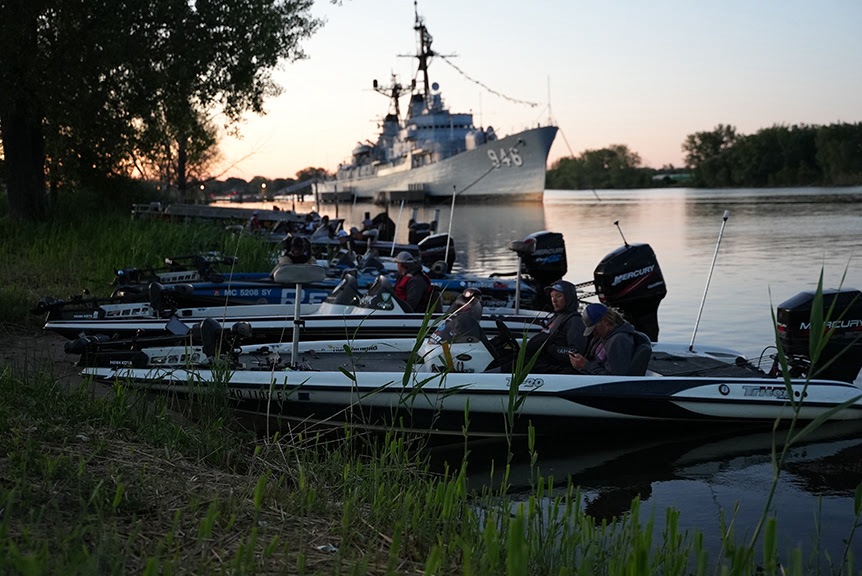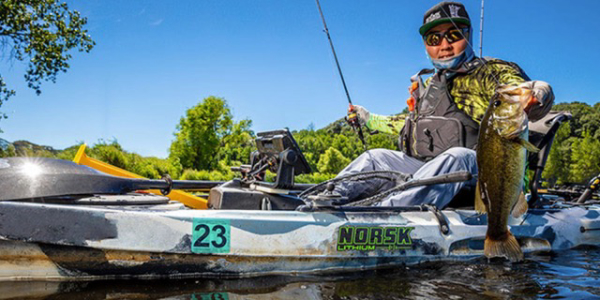The good times are now: Smallmouth bass fishing has never been better in Lake St. Clair
By JAN-MICHAEL HESSENAUER, fisheries research biologist and MARCEE WARDELL, communications specialist, both from the Michigan Department of Natural Resources
Now is the best time to be a bass angler on Lake St. Clair in at least the last 50 years.
Lake St. Clair in southeastern Michigan, consistently rated as a top 10 bass fishing lake by Bassmaster Magazine, is a popular destination fishery for high-level professional fishing tournaments and fishing enthusiasts from around the world.
 Anglers love this opportunity to connect with nature, that feeling of a tug on the line and a beautiful fish in their hands. Anglers love this opportunity to connect with nature, that feeling of a tug on the line and a beautiful fish in their hands.
This isn’t just hype – smallmouth bass are thriving in Lake St. Clair, despite the presence of invasive species, an intense fishery and other perceived or potential threats.
A new research study from the Michigan Department of Natural Resources’ Lake St. Clair Fisheries Research Station looked at this fish population to explore what might contribute to its success.
What they found might surprise even the most avid Lake St. Clair anglers.
Why study smallmouth bass?
Not only are smallmouth bass valuable to anglers (and to the local economy of fishing- and tourism-related businesses), they are also considered a keystone species. This means that smallmouth bass play a critical role in engineering the aquatic ecosystem.
“Smallmouth bass prey on a range of smaller species like crayfish and minnows,” said DNR fisheries biologist Cleyo Harris. “Through this predation, they help keep the ecosystem in balance, leading to improved growth rates for other popular species, like bluegill. This effect trickles down through the food web, helping to control algal abundance and improve water clarity.”
Using the DNR’s long-term monitoring program in Lake St. Clair’s Anchor Bay, researchers summarized trends in smallmouth bass population data from two time periods to compare past and present: 1972-1985 and 2002-2023. |
 They discovered large increases in the number of big (17 inches and larger) and trophy-sized (20 inches and larger) smallmouth bass in the second survey period (2002-2023), while fish of these sizes were essentially absent during the earlier period. They discovered large increases in the number of big (17 inches and larger) and trophy-sized (20 inches and larger) smallmouth bass in the second survey period (2002-2023), while fish of these sizes were essentially absent during the earlier period.
Between 2002 and 2023, the biomass of smallmouth bass (the average total weight of smallmouth bass per sample) remained relatively stable, while providing increasing opportunities for anglers to catch trophy-sized fish.
Interestingly, the study found that smallmouth bass growth rates have been increasing since the 1970s. This is meaningful because drastic changes have occurred in Lake St. Clair and the Great Lakes in recent decades, due to the dual invasion of dreissenid mussels (zebra and quagga mussels) and round goby.
Dreissenid mussels filter a lot of water, pulling nutrients from the open waters and surface of the Great Lakes and concentrating them on the bottom, making those nutrients available to bottom-dwelliing fish like round goby when they consume the zebra or quagga mussels.
The best thing to happen to smallmouth bass?
The DNR researchers originally believed that the changes in Great Lakes energy flows initiated by invasive dreissenids and round goby, the latter of which are now a common part of smallmouth bass diets, might be responsible for the larger sizes of smallmouth bass observed in Lake St. Clair.
This theory is also popular with anglers.
“Round goby are the best thing to ever happen to smallmouth bass,” is a common refrain among bass anglers in the area. |
 But the data suggests otherwise. But the data suggests otherwise.
Smallmouth bass growth has been increasing at a small but steady rate since the 1970s and 1980s – likely a response to improved water quality, changes in the length of the growing season or climatic differences.
Round goby were not observed in Lake St. Clair until 1990, and the long-term change in growth rate of smallmouth bass was the same in the periods before and after round goby introduction.
So, what changed?
Long live smallmouth bass
Simply put, between the 1970s and today, smallmouth bass started living longer.
Historically, the average age of smallmouth bass was approximately 4.5 years old, but the average age of the population has increased steadily over time and now exceeds 7 years old.
Similarly, the average number of year classes (different ages of fish) observed in the population increased in the later study period compared to the 1970s and 1980s.
This indicates that the increased average age was the result of adding more older year classes – fish living longer – and not a loss of younger fish.
Round goby are known to be nest predators, and many were concerned that their presence could reduce smallmouth bass nesting success and harm the population, particularly younger age classes.
This concern has not been realized in Lake St. Clair. |
 Instead, smallmouth bass have enjoyed steady spawning success and survival to older ages, especially since 2002. A longer lifespan gives smallmouth bass more opportunity to grow and reach large and trophy sizes, while also providing more opportunity for fish to spawn. Instead, smallmouth bass have enjoyed steady spawning success and survival to older ages, especially since 2002. A longer lifespan gives smallmouth bass more opportunity to grow and reach large and trophy sizes, while also providing more opportunity for fish to spawn.
That means there are more and bigger smallmouth bass in the Lake St. Clair system today than any time in the last 50 years.
Another interesting trend in the study data is that the overall mortality rate for smallmouth bass has continued to decline in recent years, even after the catch-and-release season was extended to year-round in 2015.
Increasing the opportunity to fish for smallmouth bass has not resulted in increased mortality at the population scale.
Changes in fishing practices may be partially responsible for longer lives, bigger fish and decreased smallmouth bass mortality.
Angler harvest rates for smallmouth bass have fallen since the 1970s. Today, more than 95% of smallmouth caught by anglers in Lake St. Clair are voluntarily released alive.
In fact, the decline in angler harvest has exceeded the decline in mortality rates, suggesting that the population could handle more catch-and-keep fishing. If you like taking smallmouth from Lake St. Clair, keep at it.
“In the mid-1990s, the Lake St. Clair smallmouth bass population was strong, and the fishery was already attracting national attention among bass anglers and bass fishing organizations,” said retired DNR fisheries biologist Mike Thomas. “Despite invasive species, improved fishing technology, liberalized bass fishing regulations and environmental changes, the smallmouth bass population is now stronger than ever. |
 “Bass anglers should be proud of their dedication to the conservation ethic, which has supported this ongoing boom in the smallmouth bass fishery.” “Bass anglers should be proud of their dedication to the conservation ethic, which has supported this ongoing boom in the smallmouth bass fishery.”
Long-term DNR research studies like this one are valuable because they provide opportunities to evaluate trends in important fish species over the course of decades.
This allows fisheries managers to evaluate the effects of invasive species such as round goby, as well as changes in how people are fishing for species like smallmouth bass.
In Lake St. Clair, the data show that the excellent fishery of today is the result of multiple factors, including successful natural reproduction, fish living longer and ample prey resources.
These improvements, however, were not solely linked with the proliferation of a new food source, the invasive round goby.
“Since the early 2000s, round goby has spread to multiple inland waterbodies in Michigan, based on monitoring efforts and research, including in the Flint, Shiawassee and Saginaw rivers,” said Justin Bopp, DNR Fisheries Division aquatic invasive species coordinator.
The continued spread of round goby into other Michigan inland waters remains a threat, unbalancing these ecosystems and outcompeting native species for food and habitat.
Anglers have a part to play in preventing the spread of the invasive round goby, which are a prohibited species in Michigan. It’s illegal to possess or introduce these invasive fish, so don’t use live round goby for bait fish or attempt to stock them in any waters, public or private, in hopes of boosting the bass population.
Report any round goby observations to the Midwest Invasive Species Information Network via its online reporting tool or the MISIN smartphone app.
Bopp recommends that anglers help prevent round goby invading inland bodies of water by washing boats, trailers and fishing gear to help minimize the species’ spread throughout Michigan.
Learn more about round goby and their effects on Michigan’s waters.
In the last 50 years, there has never been a better time to be a bass angler on Lake St. Clair.
With the abundance of large and trophy-sized fish, the good times truly are now!
If you’re interested in reading the full research study, reach out to Jan-Michael Hessenauer at HessenauerJ1@Michigan.gov.
Learn more about smallmouth bass in Michigan. |
Check out previous Showcasing the DNR stories in our archive at Michigan.gov/DNRStories. To subscribe to upcoming Showcasing articles, sign up for free email delivery at Michigan.gov/DNREmail.
Note to editors: Contact: John Pepin, Showcasing the DNR series editor, 906-226-1352. Accompanying photos and a text-only version of this story are available below for download. Caption information follows. Credit Michigan Department of Natural Resources, unless otherwise noted. |


 Anglers love this opportunity to connect with nature, that feeling of a tug on the line and a beautiful fish in their hands.
Anglers love this opportunity to connect with nature, that feeling of a tug on the line and a beautiful fish in their hands.
 They discovered large increases in the number of big (17 inches and larger) and trophy-sized (20 inches and larger) smallmouth bass in the second survey period (2002-2023), while fish of these sizes were essentially absent during the earlier period.
They discovered large increases in the number of big (17 inches and larger) and trophy-sized (20 inches and larger) smallmouth bass in the second survey period (2002-2023), while fish of these sizes were essentially absent during the earlier period.
 But the data suggests otherwise.
But the data suggests otherwise.
 Instead, smallmouth bass have enjoyed steady spawning success and survival to older ages, especially since 2002. A longer lifespan gives smallmouth bass more opportunity to grow and reach large and trophy sizes, while also providing more opportunity for fish to spawn.
Instead, smallmouth bass have enjoyed steady spawning success and survival to older ages, especially since 2002. A longer lifespan gives smallmouth bass more opportunity to grow and reach large and trophy sizes, while also providing more opportunity for fish to spawn.
 “Bass anglers should be proud of their dedication to the conservation ethic, which has supported this ongoing boom in the smallmouth bass fishery.”
“Bass anglers should be proud of their dedication to the conservation ethic, which has supported this ongoing boom in the smallmouth bass fishery.”





